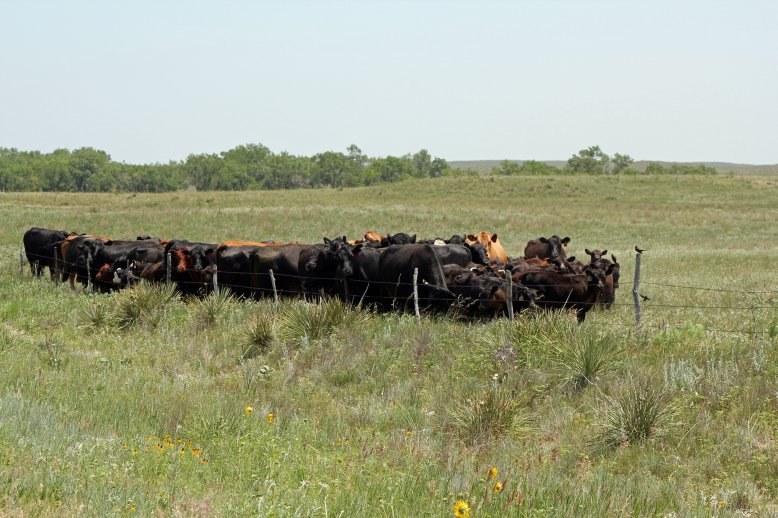
By Dave Boxler, Extension Educator
We have now entered the mid-point of summer and it is time to evaluate our pasture fly control efforts. Some areas of Nebraska have received significant rainfall during the last few weeks which is beneficial for our crops and pastures. But abundant moisture can also promote pasture fly populations which can ultimately affect cattle weight gain performance. As we progress through the last part of summer livestock producers need to evaluate their present fly control methods. If the current method is not providing the desired level of fly control; now is the time to change to a method that will to reduce the impact of pasture flies on cattle performance.
There are three fly species in Nebraska that economically impact pastured cattle; horn fly, face fly, and stable fly.
Horn Fly
Presently, horn fly numbers on untreated cattle in many areas of Nebraska are averaging more than 500 flies per animal (Figure 1 - http://go.unl.edu/9qu) which is significantly higher than the economic injury level (EIL) of 200 flies per animal. When horn fly numbers are above the (EIL) cattle will experience annoyance, blood loss, changes in grazing patterns and bunching of animals. Significant reduction in calf weaning weights is well documented. Nebraska studies demonstrated calf weaning weights were 10 to 20 pounds higher when horn flies were controlled on mother cows. Other studies in the U.S. and Canada have shown improved weight gains of stocker cattle and replacement heifers when comparing horn fly protected animals to unprotected animals. Routine observations will help livestock producers determine when best to initiate control methods and the efficacy of their current program. Cattle should be monitored weekly for horn flies throughout the fly season. Observations are best taken between the hours of 9:00 AM to 1:00 PM when horn flies are located on the shoulders and sides of cattle. Observations made later in the day are less accurate because the flies will have moved to the belly where it is cooler and where they are harder to observe. If the average number horn flies per animal exceeds 200 (Figure 2 - http://go.unl.edu/6o6), the (EIL) has been exceeded and control should be considered.
Face Flies
Face fly numbers have been increasing in certain areas of the state, especially where abundant rainfall has occurred. The face fly, is a robust fly that superficially resembles the house fly. It is a nonbiting fly that feeds on animal secretions, nectar, and dung liquids. Adult female face flies typically cluster around the animals’ eyes, mouth, and muzzle, causing extreme annoyance (Figure 3 - http://go.unl.edu/4ua). They are also facultative blood feeders, meaning that they gather around wounds caused by mechanical damage or other injury to feed on blood and other exudates. Because face flies are on animals for only short time periods they are difficult to control. Most of the time face flies are found resting on plants, fence posts and other objects.
In addition to being very annoying, face flies vector Moraxella bovis, the principal causal agent of bovine pinkeye or infectious bovine keratoconjunctivitis. Pinkeye is a highly contagious inflammation of the cornea and conjunctiva of cattle. If coupled with the infectious bovine rhinotracheitis (IBR) virus, M. bovis can cause a much more severe inflammatory condition.
Controlling face fly numbers is a key to reducing pink-eye problems. Insecticide ear tags generally provide a higher degree of face fly control, but both cows and calves must be treated if control is to be achieved.
In respect to pink-eye vaccines, if you have experienced significant pink-eye problems in the past, vaccines are available and may be a good option. Please check with a local veterinarian about the use of these products in a specific geographical area.
Stable Flies
Stable fly numbers on pastured cattle have increased dramatically during the last few weeks across most of Nebraska. Again areas within the state which have received abundant moisture will continue to see stable flies annoying their pastured cattle. Stable fly populations will start to decline as hot dry weather enters the state. Stable flies are blood feeding flies, mainly feeding on the legs of cattle (Figure 4 - http://go.unl.edu/r44). To avoid being bitten, animals stomp their feet and switch their tails. Other avoidance behaviors include standing in water, lying with legs tucked underneath and bunching at the corners of pastures. The effect of stable flies on weight gain performance of pastured cattle is similar to that of livestock in confined operations. Research conducted at the University of Nebraska, West Central Research & Extension Center recorded a reduction in average daily gain of 0.44 lb per head per day in 84-day trials with animals that did not receive an insecticide treatment compared to cattle that received an insecticide application. The economic threshold of five flies per leg is easily exceeded in Nebraska pasture conditions. Areas of decomposing organic matter, including grass clippings and poorly managed compost piles also may be stable fly breeding areas. Winter hay feeding sites where hay rings are used can often produce stable flies through the summer if the proper amount of moisture is present.
The only adult management option available for the control of stable flies on range cattle is use of animal sprays. Sprays can be applied using a low pressure sprayer or can be applied with a mist blower sprayer. Weekly applications of these products will be required to achieve reduction in fly numbers. Sanitation or clean-up of wasted feed at winter feeding sites may reduce localized fly development. If sanitation is not possible these sites may be treated with a larvicide (Neporex®). However, the implementation of either procedure may not reduce the economic impact of stable fly feeding.
For current Nebraska control recommendations go to: http://entomology.unl.edu/livestock/2013flyrecs.shtml
For additional information, please contact Dave Boxler at 308-696-6721 or at dboxler1@unl.edu
For more UNL Beef information go to http://beef.unl.edu